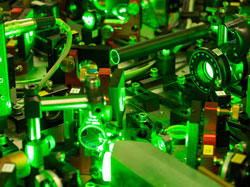Laser interferometers detect tiny distance changes with high precision. Stray light reduces and limits the measurement accuracy of these instruments. Researchers at the Albert Einstein Institute in Hannover have now shown for the first time how to discriminate between measurement signal and stray light using lasers with tailored quantum properties. The novel measurement concept circumvents the Heisenberg uncertainty principle and could enhance the precision of gravitational-wave detectors like GEO600 or the closely cooperating Advanced LIGO (aLIGO) detectors in the USA.
The scientists at the Albert Einstein Institute (AEI; Institute for Gravitational Physics at Leibniz Universität Hannover and Max Planck Institute for Gravitational Physics) in Hannover are hunting for elusive gravitational waves—a prediction from Einstein's general theory of relativity. Their first direction detection will open a new window to our Universe and usher in the era of gravitational-wave astronomy. The AEI researchers aim to detect these tiny space-time ripples using detectors like GEO600 near Hannover, Germany, and aLIGO in the U.S. These detectors use lasers to measure the tiny distance changes caused by passing gravitational waves. Thus, the continuous improvement of those lasers and the minimization of disturbances like stray laser light is of great importance.
R&D Mag: Outsmarting Heisenberg

Comments